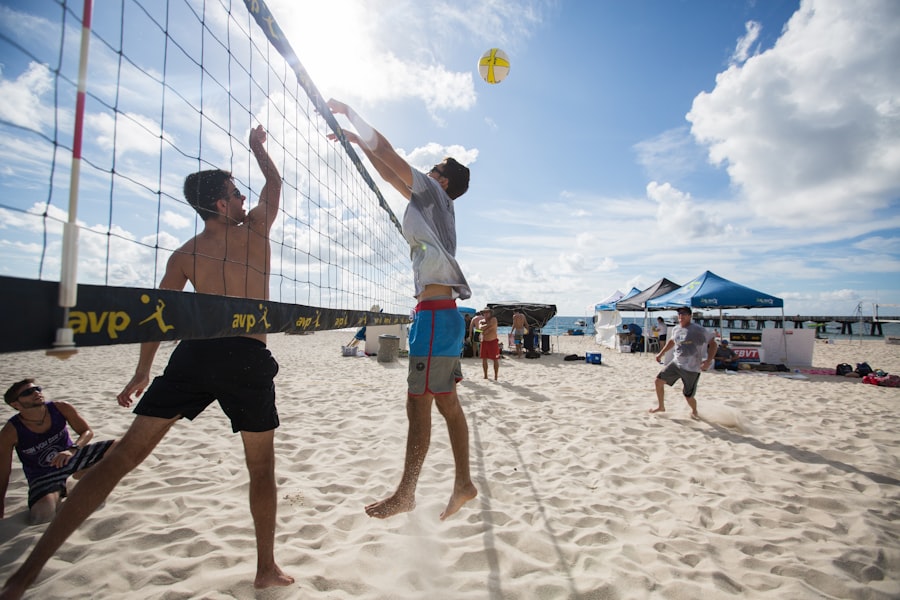Download links
How to install Mastering the Art of Volleyball: Tips for Success APK?
1. Tap the downloaded Mastering the Art of Volleyball: Tips for Success APK file.
2. Touch install.
3. Follow the steps on the screen.
Description
Volleyball is a dynamic sport that combines elements of athleticism, strategy, and teamwork. Originating in the United States in 1895, it has evolved into a global phenomenon, played both indoors and on the beach. The game is played by two teams, each consisting of six players, who aim to score points by sending a ball over a net and into the opposing team’s court.
The fundamental objective is to ground the ball on the opponent’s side while preventing them from doing the same. Each team is allowed three touches to return the ball, which typically involves a combination of passing, setting, and spiking. The court dimensions are standardized, measuring 18 meters long and 9 meters wide, divided by a net that stands at 2.43 meters high for men and 2.24 meters for women.
Understanding the layout of the court is crucial for players, as it dictates their positioning and movement during play. The game is played in sets, with a team needing to win three out of five sets to claim victory. Each set is played to 25 points, but a team must win by at least two points.
This scoring system adds an element of strategy, as teams must not only focus on scoring but also on maintaining a lead and managing pressure during close sets.
Key Takeaways
- Volleyball is a team sport played with six players on each side, aiming to score points by grounding the ball on the opponent’s court.
- Proper technique and form are essential for successful volleyball play, including passing, setting, hitting, and serving.
- Improving footwork and agility is crucial for players to move quickly and efficiently around the court to reach the ball and make plays.
- Mastering the art of serving involves developing different types of serves, such as the float serve, jump serve, and topspin serve.
- Communication and teamwork are key components of successful volleyball play, requiring players to effectively communicate and work together to achieve their goals on the court.
- Effective spiking and blocking strategies involve timing, positioning, and coordination with teammates to execute successful offensive and defensive plays.
- Utilizing defensive skills and positioning is important for players to anticipate and react to the opponent’s attacks, including digging, blocking, and positioning on the court.
- Mental preparation and focus on the court are essential for players to stay composed, make quick decisions, and maintain a positive mindset during intense volleyball matches.
Developing Proper Technique and Form
Mastering volleyball requires a solid foundation in technique and form. Each skill—whether it be serving, passing, or spiking—demands specific body mechanics that can significantly impact performance. For instance, when executing a serve, players must focus on their grip, stance, and follow-through.
A proper serve begins with a stable base; players should stand with their feet shoulder-width apart, knees slightly bent, and weight distributed evenly. The non-dominant hand holds the ball at waist height while the dominant hand prepares to strike. This initial positioning sets the stage for a powerful and accurate serve.
Players should adopt a low stance with their knees bent and arms extended in front of them. The technique involves using the forearms to create a platform for the ball to bounce off, ensuring that it is directed accurately to the setter.
Proper hand positioning is essential; players should keep their hands relaxed and fingers spread wide when setting the ball. This allows for better control and precision in delivering the ball to attackers. Consistent practice of these techniques not only enhances individual skills but also builds muscle memory, which is vital during high-pressure game situations.
Improving Footwork and Agility

Footwork is often an overlooked aspect of volleyball training, yet it plays a pivotal role in a player’s overall performance. Quick and agile footwork allows players to position themselves optimally for every play, whether they are receiving a serve or preparing to spike. Effective footwork begins with understanding the basic movements required on the court.
Players should practice lateral shuffles, quick steps forward and backward, and diagonal movements to enhance their agility. Drills that incorporate these movements can significantly improve a player’s ability to react swiftly during matches. Incorporating agility drills into training routines can further enhance footwork.
For example, ladder drills are an excellent way to develop quick feet and coordination. Players can set up an agility ladder on the court and practice various patterns such as high knees, side steps, and in-and-out movements. These drills not only improve speed but also help players develop better balance and coordination.
Additionally, plyometric exercises like box jumps or lateral bounds can build explosive strength in the legs, enabling players to jump higher for blocks or spikes while maintaining control over their landings.
Mastering the Art of Serving
| Metrics | Value |
|---|---|
| Customer Satisfaction | 95% |
| Service Quality | Excellent |
| Response Time | Under 5 minutes |
| Customer Retention | 80% |
Serving is often considered one of the most critical skills in volleyball because it initiates each rally and can set the tone for the entire match. There are several types of serves that players can master, including the underhand serve, overhand serve, and jump serve. Each type has its advantages and can be strategically employed depending on the situation.
The underhand serve is typically easier for beginners to learn as it requires less power and precision than other serves. However, as players progress, they often transition to more advanced techniques like the overhand serve or jump serve. The overhand serve involves tossing the ball into the air before striking it with an open hand.
This technique requires precise timing and coordination; players must ensure that their toss is consistent and that they make contact with the ball at its highest point for maximum power.
Practicing these serves regularly not only builds confidence but also enhances a player’s ability to score points directly from their serve.
Enhancing Communication and Teamwork
Effective communication is essential in volleyball, where split-second decisions can determine the outcome of a play. Players must develop a strong rapport with their teammates to ensure seamless coordination on the court. This involves not only verbal communication but also non-verbal cues such as eye contact and body language.
For instance, calling for the ball loudly and clearly helps prevent confusion during plays where multiple players may be vying for possession. Teamwork extends beyond communication; it encompasses understanding each player’s strengths and weaknesses. Coaches often emphasize the importance of team drills that foster collaboration among players.
For example, running scrimmages where players rotate positions can help them appreciate each other’s roles within the team dynamic. Additionally, post-game discussions can provide valuable insights into what worked well and what needs improvement, reinforcing a culture of continuous learning and adaptation.
Strategies for Effective Spiking and Blocking

Perfecting the Spike
To execute an effective spike, players must focus on timing their jump with their approach run. A common strategy involves taking three quick steps before jumping—this rhythm allows for maximum elevation and power during the spike.
Developing Versatility in Attacking
Players should also practice hitting from various angles on the court to develop versatility in their attacking style.
Mastering the Block
A successful block requires anticipation and timing; players must read their opponents’ movements to position themselves effectively at the net. When executing a block, players should aim to jump straight up with their arms extended above their heads while keeping their body aligned with the net. This technique maximizes coverage against potential spikes while minimizing gaps that attackers could exploit. Regularly practicing blocking drills with teammates can enhance timing and coordination between blockers.
Utilizing Defensive Skills and Positioning
Defensive skills are crucial in volleyball as they determine how well a team can respond to attacks from opponents. Players must be adept at digging—an essential skill used to receive powerful spikes or serves from opponents. To dig effectively, players should adopt a low stance with their knees bent and arms ready to react quickly.
The key is to maintain a strong platform with their forearms while keeping their eyes on the ball at all times. Positioning on the court is another vital aspect of defense; players must understand where to stand based on their opponents’ tendencies and court dynamics. For instance, defensive specialists often position themselves strategically behind blockers to cover any potential gaps left open during plays.
Coaches frequently analyze opponents’ hitting patterns to adjust defensive formations accordingly. By studying these patterns during practice sessions or matches, players can enhance their ability to anticipate plays and respond effectively.
Mental Preparation and Focus on the Court
Mental preparation is often an overlooked component of athletic performance in volleyball yet plays a significant role in how players perform under pressure. Developing mental resilience involves cultivating focus, confidence, and composure during matches. Visualization techniques can be particularly effective; players can mentally rehearse successful plays or visualize themselves executing skills flawlessly before stepping onto the court.
Additionally, mindfulness practices such as deep breathing exercises can help players manage anxiety and maintain concentration during high-stakes moments in games. Establishing pre-game routines that include positive affirmations or relaxation techniques can also enhance mental readiness. Coaches often encourage athletes to reflect on past performances—both successes and failures—to build confidence while learning from experiences.
By fostering a strong mental game alongside physical skills, players can elevate their overall performance on the court significantly. In conclusion, volleyball is a multifaceted sport that requires dedication to mastering various skills ranging from technique to mental preparation. By focusing on each aspect—whether it be serving or teamwork—players can develop into well-rounded athletes capable of excelling in competitive environments.
If you’re looking to enhance your volleyball experience, you may want to check out Taya777’s article on maximizing your sports betting experience with Taya777 online sports. This article provides valuable tips and insights on how to make the most out of your sports betting activities while enjoying the game of volleyball. You can read more about it here.
FAQs
What is volleyball?
Volleyball is a team sport in which two teams of six players are separated by a net. The objective is to score points by grounding the ball on the opposing team’s court.
What are the basic rules of volleyball?
The basic rules of volleyball include serving the ball over the net, rallying to keep the ball in play, and trying to score points by grounding the ball on the opposing team’s court. Each team is allowed three touches to return the ball.
What are the different types of volleyball games?
There are several variations of volleyball, including indoor volleyball, beach volleyball, and sitting volleyball. Each variation has its own set of rules and playing environment.
What equipment is needed to play volleyball?
The main equipment needed to play volleyball includes a volleyball, a net, and appropriate footwear. Players may also wear knee pads and other protective gear.
What are the health benefits of playing volleyball?
Playing volleyball can improve cardiovascular health, enhance muscle strength and coordination, and promote teamwork and communication skills. It is also a great way to stay active and socialize with others.
What are the key skills needed to excel in volleyball?
Key skills needed to excel in volleyball include serving, passing, setting, attacking, blocking, and digging. Players also need good communication and teamwork skills to succeed in the sport.





